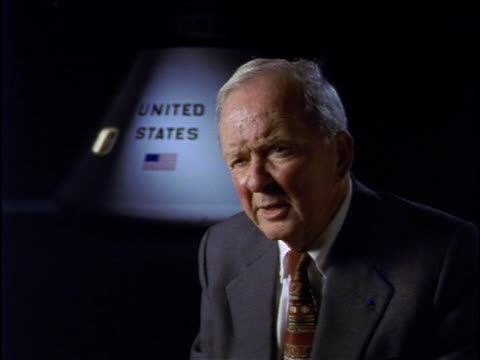NOVA; To the Moon; Interview with Thomas Joseph Kelly, aerospace engineer responsible for working on the Apollo Lunar Module, part 3 of 3
- Series
- NOVA
- Episode
- To the Moon
- Producing Organization
- WGBH Educational Foundation
- Contributing Organization
- WGBH (Boston, Massachusetts)
- AAPB ID
- cpb-aacip-15-r49g44k277
If you have more information about this item than what is given here, or if you have concerns about this record, we want to know! Contact us, indicating the AAPB ID (cpb-aacip-15-r49g44k277).
- Description
- Program Description
- This remarkably crafted program covers the full range of participants in the Apollo project, from the scientists and engineers who promoted bold ideas about the nature of the Moon and how to get there, to the young geologists who chose the landing sites and helped train the crews, to the astronauts who actually went - not once or twice, but six times, each to a more demanding and interesting location on the Moon's surface. "To The Moon" includes unprecedented footage, rare interviews, and presents a magnificent overview of the history of man and the Moon. To the Moon aired as NOVA episode 2610 in 1999.
- Raw Footage Description
- Thomas Joseph Kelly, aerospace engineer responsible for working on the Apollo Lunar Module, is interviewed about the Apollo 13 mission. Kelly determined that the LM was designed to be usable as a lifeboat, although the astronauts were never trained on this contingency. Kelly explains some of his reservations on the subsequent Apollo missions, including Apollo 14's issues with its spacecraft's docking and its panic button, and explains how the Apollo 14 mission was saved. Kelly believes that the Apollo program ended while NASA was ahead in terms of risks, felt that the astronauts had been highly effective in their "scientific harvest", and said that he was almost relieved when later Apollo missions were called off. Inside the Lunar Module, Kelly explains the space and mechanisms, and explains why there were no seats in the LM, and explains where the Apollo 11 crew would have been situated. Kelly explains the LM as a flying machine, shows where the docking window and hatches were, and talks about how much the astronauts loved the LM. The interview ends with Kelly's comparison of old and new space technology, and his feelings of pride. Footage ends with shots of the LM, no audio.
- Created Date
- 1998
- Asset type
- Raw Footage
- Genres
- Interview
- Topics
- History
- Technology
- Science
- Subjects
- American History; Gemini; apollo; moon; Space; astronaut
- Media type
- Moving Image
- Duration
- 00:15:51
- Credits
-
-
Interviewee: Kelly, Thomas Joseph, 1929-2002
Interviewee: Kelly, Thomas Joseph, 1929-2002
Producing Organization: WGBH Educational Foundation
- AAPB Contributor Holdings
-
WGBH
Identifier: cpb-aacip-e2d3fda4306 (Filename)
Format: Digital Betacam
Generation: Original
Duration: 0:15:51
If you have a copy of this asset and would like us to add it to our catalog, please contact us.
- Citations
- Chicago: “NOVA; To the Moon; Interview with Thomas Joseph Kelly, aerospace engineer responsible for working on the Apollo Lunar Module, part 3 of 3 ,” 1998, WGBH, American Archive of Public Broadcasting (GBH and the Library of Congress), Boston, MA and Washington, DC, accessed December 9, 2025, http://americanarchive.org/catalog/cpb-aacip-15-r49g44k277.
- MLA: “NOVA; To the Moon; Interview with Thomas Joseph Kelly, aerospace engineer responsible for working on the Apollo Lunar Module, part 3 of 3 .” 1998. WGBH, American Archive of Public Broadcasting (GBH and the Library of Congress), Boston, MA and Washington, DC. Web. December 9, 2025. <http://americanarchive.org/catalog/cpb-aacip-15-r49g44k277>.
- APA: NOVA; To the Moon; Interview with Thomas Joseph Kelly, aerospace engineer responsible for working on the Apollo Lunar Module, part 3 of 3 . Boston, MA: WGBH, American Archive of Public Broadcasting (GBH and the Library of Congress), Boston, MA and Washington, DC. Retrieved from http://americanarchive.org/catalog/cpb-aacip-15-r49g44k277
